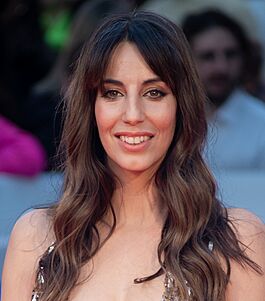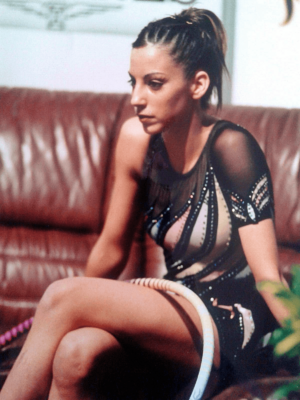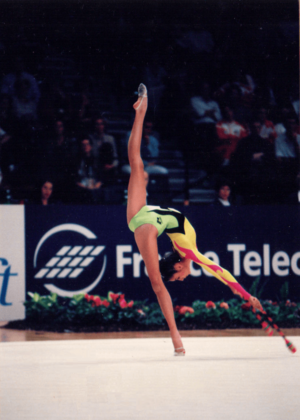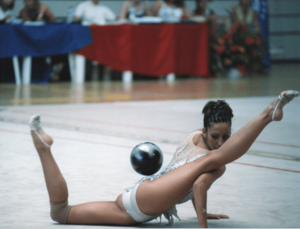Almudena Cid facts for kids
Quick facts for kids Almudena Cid |
|||||||||||||||||
|---|---|---|---|---|---|---|---|---|---|---|---|---|---|---|---|---|---|

Cid attending a Festival de Málaga in 2024.
|
|||||||||||||||||
| Personal information | |||||||||||||||||
| Full name | Almudena Cid Tostado | ||||||||||||||||
| Country represented | |||||||||||||||||
| Born | June 15, 1980 Vitoria, Spain |
||||||||||||||||
| Height | 167 cm (5 ft 6 in) | ||||||||||||||||
| Discipline | Rhythmic gymnastics | ||||||||||||||||
| Years on national team | 1994~2008 | ||||||||||||||||
| Club | Beti Aurrera | ||||||||||||||||
| Assistant coach(es) | Anna Baranova | ||||||||||||||||
| Former coach(es) | Iratxe Aurrekoetxea | ||||||||||||||||
| Eponymous skills | Cid Tostado Element (ball) | ||||||||||||||||
| Retired | 2008 | ||||||||||||||||
|
Medal record
|
|||||||||||||||||
Almudena Cid Tostado (born on June 15, 1980, in Vitoria, Spain) is a famous former Spanish rhythmic gymnast. She was part of the Spanish national team for many years.
Almudena is special because she is the only rhythmic gymnast in history to have competed in four Olympic finals. She reached the finals at the Atlanta 1996, Sydney 2000, Athens 2004, and Beijing 2008 Games.
She also won a gold medal at the Mediterranean Games in Almería in 2005. Almudena has received many awards for her sports career. One important award was the gold medal in the Royal Order of Sports Merit in 2009. This award recognizes great achievements in sports in Spain.
In 2001, the International Gymnastics Federation (FIG) officially named a special move after her. It's called the "Cid Tostado element" with the ball. This move involves rolling the ball over both legs while starting on one knee.
After a long career of 21 years, Almudena retired from rhythmic gymnastics on August 23, 2008. Today, she works as a sports commentator for gymnastics events. Since 2014, she has also been writing a series of children's books called Olympia. In these books, she shares stories about her life as an athlete.
Contents
Starting Her Gymnastics Journey
Almudena started rhythmic gymnastics when she was seven years old. She first joined the Arabatxo club and then the Beti Aurrera club in Vitoria. Other well-known gymnasts, like Tania Lamarca, also trained at Beti Aurrera. Her coaches there were Aurora Fernández del Valle and Iratxe Aurrekoetxea. Almudena looked up to the Russian gymnast Oxana Kostina as one of her early inspirations.
In May 1994, when she was 13, Almudena competed in her first international competition. She won three medals: one gold and two bronze. Later that year, in November, Emilia Boneva invited her to join the Spanish national individual team in Madrid. There, Almudena trained for about eight hours a day at the Gimnasio Moscardó.
In 1995, Almudena became a top gymnast at the Spanish Individual Championships. In June of that year, she placed 12th at the Final European Cup in Telford, England.
Competing at the Senior Level
Almudena Cid achieved many awards throughout her senior career, including her impressive Olympic appearances.
Atlanta 1996 Olympics
In 1996, Almudena went to her first Olympic Games in Atlanta. She competed as an individual gymnast alongside her teammate Alba Caride. She finished fifth in the first round and ninth in the semi-final. In the Olympic final, she placed ninth overall. Almudena was the youngest gymnast competing in the final at those Games.
Sydney 2000 Olympics
Almudena's strong performances at the European Championship in Zaragoza helped her get chosen for the 2000 Sydney Olympics. Once again, she achieved the ninth position in the final.
After these Games, Almudena moved to Barcelona. She started working again with her former coach, Iratxe, who helped motivate her in her gymnastics journey.
Athens 2004 Olympics
Before the 2004 Athens Olympics, the Spanish Gymnastics Federation held a special competition. Almudena Cid and Jennifer Colino competed against each other to decide who would represent Spain. This competition was very intense and challenging for both gymnasts. Almudena earned the best scores and was selected for the Athens Games.
At the Athens Olympics, Almudena reached her third Olympic final. No other rhythmic gymnast had done this before. In the final, which took place on August 29, she finished in eighth place. This earned her an Olympic diploma.
Beijing 2008 Olympics
Almudena was chosen to represent Spain at the 2008 Beijing Olympics. These were her fourth and final Olympic Games. She again placed eighth in the final, earning another Olympic diploma.
| Olympic Games | Position | Apparatus/Score | Total Score |
|---|---|---|---|
| 1996 Atlanta Olympics | 9th | Rope 9.700
Clubs 9.683 Ball 9.566 Ribbon 9.566 |
38.515 |
| 2000 Sydney Olympics | 9th | Rope 9.750
Hoop 9.725 Ball 9.691 Ribbon 9.741 |
38.907 |
| 2004 Athens Olympics | 8th | Ribbon 23.425
Clubs 24.900 Ball 25.000 Hoop 25.125 |
98.450 |
| 2008 Beijing Olympics | 8th | Rope: 17.000
Hoop: 17.000 Clubs: 17.150 Ribbon: 16.950 |
68.100 |
Retirement from Gymnastics
Almudena Cid ended her amazing gymnastics career on August 23, 2008. This was the very last day of the Olympic finals in Beijing. Her final performance was with the ribbon, set to a beautiful song called "Nessun dorma." As a final gesture, she drew a heart shape on the gymnastics mat and kissed it.
Years later, Almudena talked about her retirement. She explained that it was hard to decide when to stop, but she chose the right moment for herself. She had worked for eight years to prove that age didn't matter in gymnastics. At 28, she showed the world she could still be a top athlete. She emphasized that rhythmic gymnastics is an art form that gets better with maturity. She fought against the idea that gymnasts have to retire very young.
Personal Life
In 2007, Almudena Cid met TV presenter Christian Gálvez. They dated for three years and got married on August 7, 2010, in Torrelodones, Madrid. They divorced in 2022.
See also
 In Spanish: Almudena Cid para niños
In Spanish: Almudena Cid para niños





